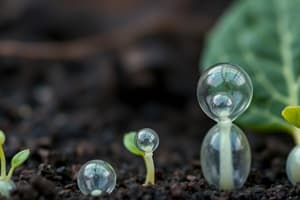Podcast
Questions and Answers
What is the primary role of water in the germination process?
What is the primary role of water in the germination process?
- To provide energy through respiration
- To absorb sunlight for photosynthesis
- To promote cell division and soften the seed coat (correct)
- To provide minerals for growth
Which of the following is a product of respiration?
Which of the following is a product of respiration?
- Carbon dioxide (correct)
- Water (correct)
- Glucose
- Oxygen
Why is warmth essential for germination?
Why is warmth essential for germination?
- It accelerates chemical reactions, including respiration. (correct)
- It increases water absorption.
- It speeds up photosynthesis.
- It activates the food store.
What substances do plants require from the air for photosynthesis?
What substances do plants require from the air for photosynthesis?
What is the significance of interdependence between plants and insects?
What is the significance of interdependence between plants and insects?
What happens to seeds if environmental resources are limited during germination?
What happens to seeds if environmental resources are limited during germination?
Which life cycle stage comes after the seedling in a tomato plant’s life cycle?
Which life cycle stage comes after the seedling in a tomato plant’s life cycle?
What can be inferred about the condition of the Judean date palm seed found in 2005?
What can be inferred about the condition of the Judean date palm seed found in 2005?
Flashcards are hidden until you start studying
Study Notes
Germination Process
- Germination requires key resources: water, warmth, and oxygen.
- Germination is the process where a seed develops into a new plant.
- Water absorption causes the seed's embryo to swell and initiate cell division.
- Water softens the seed coat, allowing the embryo to break through.
- Enzymes breakdown food stores into smaller molecules, primarily glucose, essential for growth.
- Respiration in mitochondria releases energy from glucose, summarized by the equation:
- glucose + oxygen → carbon dioxide + water (+ energy)
- Adequate warmth speeds up chemical reactions crucial for growth.
Stages and Requirements of Germination
- Essential resources for germination include:
- Water
- Oxygen
- Suitable temperature
- Seedlings need additional resources compared to germinating seeds, including light and nutrients from soil.
Interdependence of Plants and Insects
- Pollination is vital; many plants rely on insects, like bees, for reproduction, while insects depend on plants for nectar.
- Humans need pollinators for many fruits and vegetables; unpollinated plants cannot produce seeds and fruits.
- Plants provide habitat and shelter for various animals, enhancing ecosystem interdependence.
- Seeds can remain dormant for extended periods; a notable example is a 2000-year-old seed of a Judean date palm revived in 2005.
Life Cycle of a Tomato Plant
- Stages include:
- Seed
- Seedling
- Flower
- Fruit
Photosynthesis
- Takes place in chloroplasts; vital for plant growth and energy production.
- Plants require carbon dioxide and water for photosynthesis, supporting the oxygen supply needed by animals.
Impact of Honeybee Decline
- Decreasing honeybee populations threaten food production; many crops depend on bees for successful pollination, affecting human food supply.
Studying That Suits You
Use AI to generate personalized quizzes and flashcards to suit your learning preferences.




